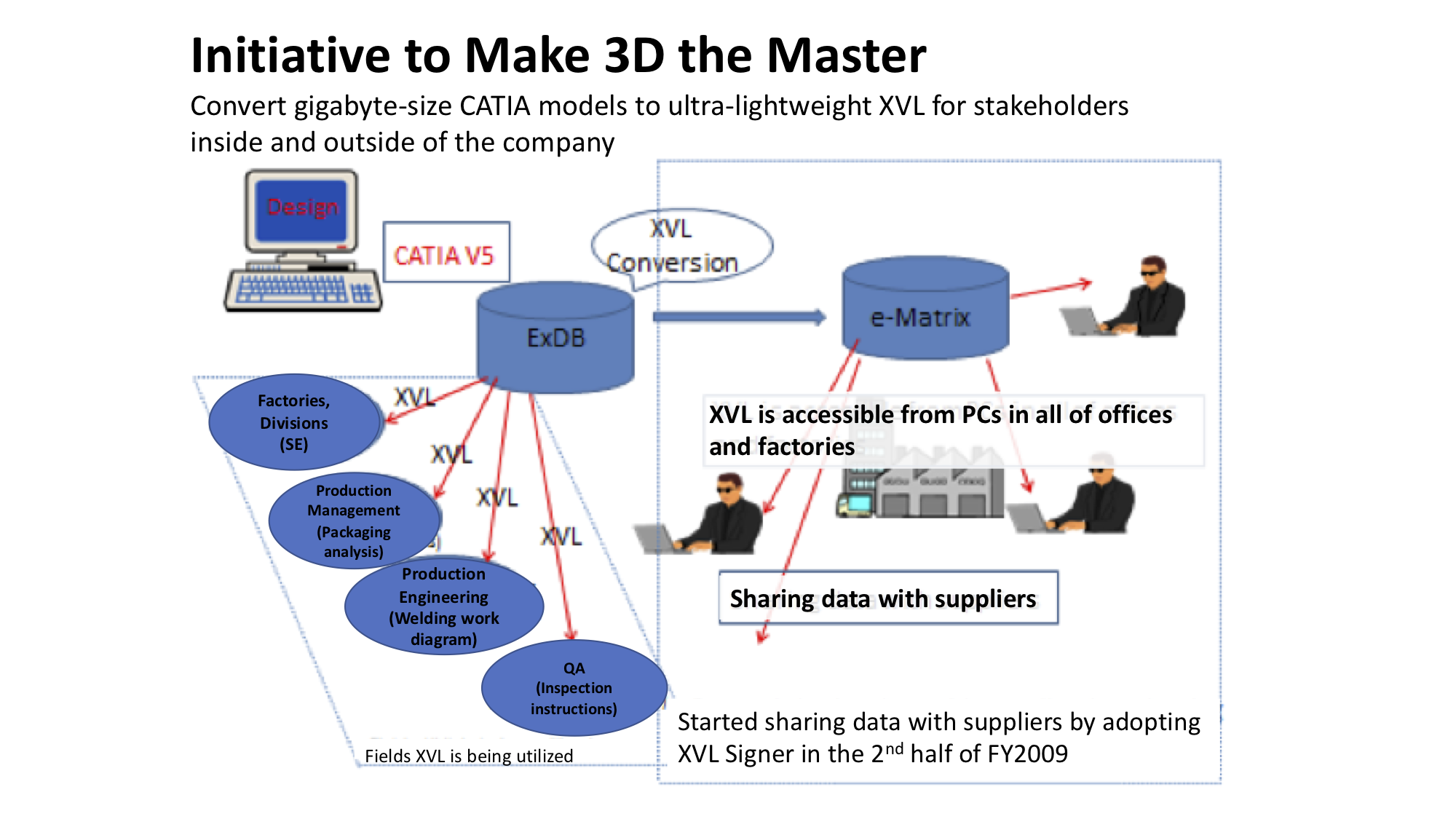
Tier-One Auto Supplier to Toyota Motor Corp. Streamlines Processes Using XVL
— XVL Customer Story: Toyoda Iron Works —
Denver, Colo. —
Corporate Profile
Toyoda Iron Works Co. Ltd. (TIW) is a tier-one Japanese auto parts supplier founded in 1946. TIW is headquartered in Toyota City and manufactures auto parts in three plants in Japan and 10 plants overseas. Their main products are steel plate body frame components and chassis parts. Seventy-five percent of their production is for Toyota Motor Corporation.
Evolution of 3D Data Utilization at Toyoda Iron Works
TIW started the transition from 2D to 3D (CATIA) in the 2000s. The transition was not easy. Several years later, 3D CAD and CAE had been rolled out to limited departments. During that time, there were no company-wide standards for CAD/CAE usage. Even though some departments were using 3D, lack of company-wide standards resulted in a lot of unnecessary rework in the late stages of design and production planning.
At the same time, Toyota Motor Corporation launched a "3D as the Master" initiative which included providing 3D data to suppliers like TIW. This triggered TIW to launch the Digital and Simultaneous Engineering Initiative.
The overall objective of the “D-SE Initiative” was to create a complete work environment centered on the 3D model and related data that enabled the Digital Engineering (DE) environment and to promote utilization of DE processes for design, Simultaneous Engineering (SE) and production planning. The initial goals were to:
- Eliminate design rework
- Reduce costs due to rework by 80%
- Reduce the overall lead time from development to production readiness.
The D-SE Initiative resulted in several projects. For example, the production management division used XVL to improve the efficiency of product packaging.
Making 3D the Master
Before the D-SE Initiative, TIW converted their 3D CAD data to 2D TIFF format to be shared with other departments. Now they convert the 3D CAD data to 3D XVL and store it in their PDM system.
Other departments can now retrieve the lightweight 3D XVL data directly from the PDM system and use it to improve their own business processes. TIW is also sharing the XVL data with their own trusted suppliers, enabling more efficient supplier communication.
Using XVL for leveraging 3D data is much easier than using 3D CAD. The main reasons are XVL’s ultralight format that retains CAD-level accuracy and being CAD-agnostic. Most often complete products are segmented into many CAD models for size or working convenience. With XVL, all of the CAD models can be brought together. Even different CAD formats that might have been gigabyte-sized files can be brought together into a single XVL file. These consolidated XVL files can then be managed by XVL Contents Manager for version control to downstream functions.
Results
TIW has obtained powerful results by building a 3D environment for automatic checking of production engineering requirements and packaging analysis. They also used XVL and 3D CAD data to improve production efficiency, increase product yield, and to check welding gun accessibility. TIW also uses XVL to virtually validate assembly processes which is much more accurate and efficient than using 2D drawings.
They also use 3D XVL data to improve client communications. The data they receive from their clients is often incomplete; it may be only part data with no assembly information, and it often lacks critical properties such as board thickness and material. TIW needs to add the missing properties and build the assemblies for the parts. With XVL, they are now able to add the required properties and build the assemblies as a post-processing task. This gives them the critical information they need to respond to client requests.
While TIW has made progress transitioning to 3D as the Master using XVL, challenges remain. Some divisions still prefer 2D because they have always done things that way and they "don't know how to use 3D." TIW is encouraging more XVL utilization by providing training, leveraging management support, adding new staff, and upgrading PCs.
Read the full Toyoda Iron Works Customer Story here.

About Us
Lattice Technology’s powerful software tools set the standard for technical communication for the manufacturing enterprise. Using Lattice Technology solutions, engineers and non-engineers alike can easily simulate assembly processes, and create work instructions or technical illustrations—directly from 3D engineering data. Solutions from Lattice Technology benefit companies who produce products with high part counts, complex geometry, detailed manufacturing processes or any ongoing lifecycle support requirements such as documentation, maintenance, and training. Target industries range from those developing large products such as airplanes and automobiles to small, complex machinery and medical devices. Founded in 1997, Lattice Technology, Inc. is headquartered in Tokyo, Japan and Westminster, CO (near Denver, Broomfield and Boulder), USA.
Contacts